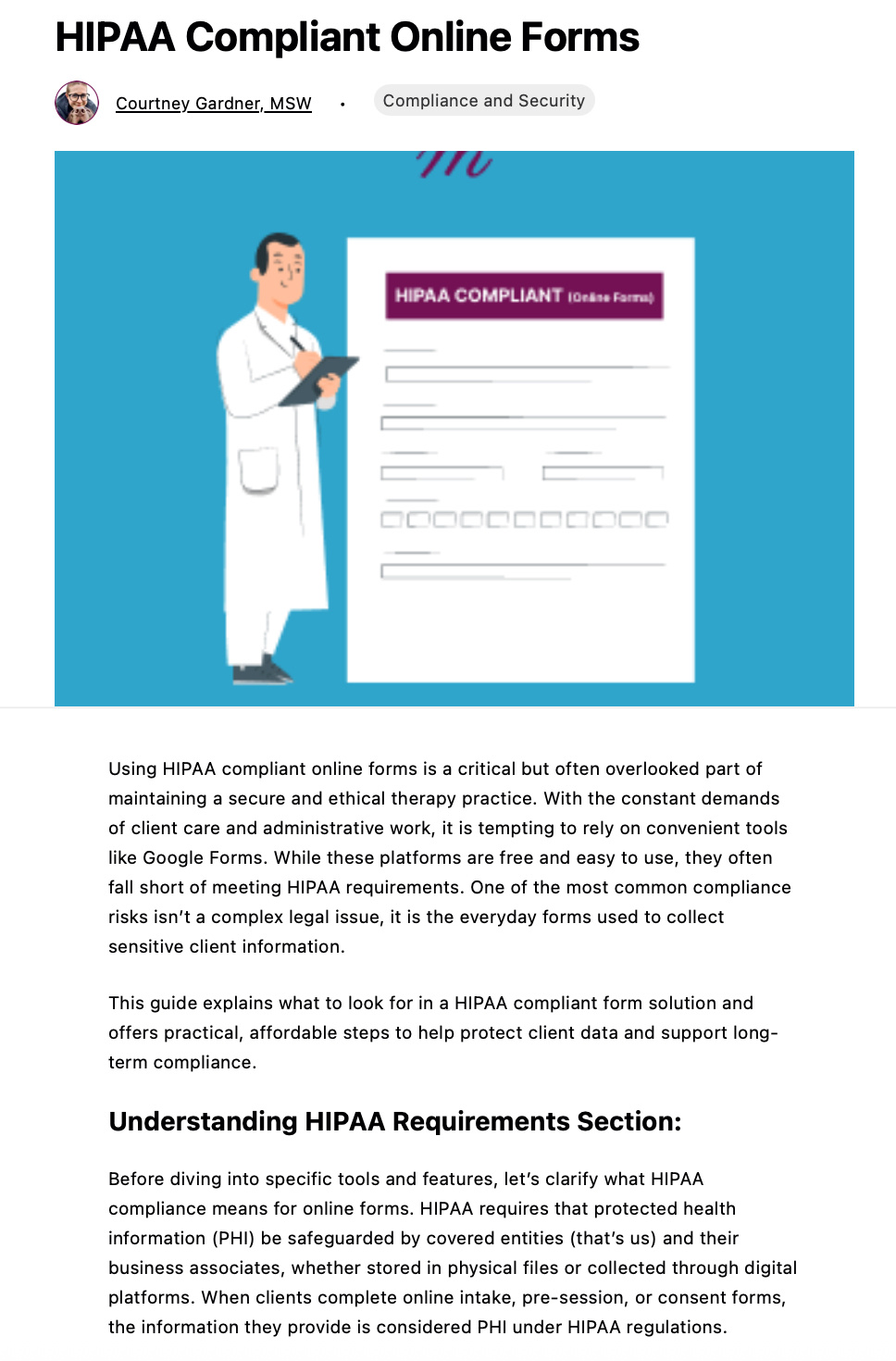Case Study: Digital Privacy and Inclusive Data Collection
Translating complex privacy regulations into practical guidance while addressing diverse organizational needs

HIPAA Compliant Online Forms Published by Mentalyc | 3,500 words | Clinical Resource
The Challenge
Client: Mentalyc (Mental health practice management platform).Project: Comprehensive guide to HIPAA-compliant online forms for mental health professionals.The Problem: Most mental health professionals inadvertently violate HIPAA requirements by using convenient but non-compliant tools like Google Forms to collect sensitive client information. Existing HIPAA guidance was either overly technical or legally focused, leaving practitioners without practical implementation guidance.Unique Complexity: This topic required translating complex legal requirements into actionable steps while addressing the intersection of data privacy, clinical ethics, and practical business needs. Content needed to serve solo practitioners and larger organizations with different resource levels.
My Approach
Research Strategy:
Reviewed HIPAA regulations, state privacy laws, and professional ethics guidelines
Analyzed technical requirements for data encryption, access controls, and audit trails
Evaluated specific platforms and their compliance features and limitations
Consulted cybersecurity best practices for healthcare settings
Key Language Decisions:
Translated legal jargon into practical terms - explaining "Business Associate Agreements" and "encryption at rest" in language busy clinicians could understand
Emphasized protective intent over punitive compliance - positioning HIPAA as client protection rather than bureaucratic burden
Provided specific, actionable comparisons - giving clear guidance on platform selection rather than vague recommendations
Acknowledged resource constraints - offering solutions for different practice sizes and budgets
Technical Accuracy Priorities:
Detailed platform-by-platform compliance analysis with specific feature requirements
Clear implementation checklists for setup and ongoing maintenance
Cost-benefit analysis to help practices make informed decisions
Integration guidance for existing practice management systems
The Result
What I Delivered:
A 3,500+ word guide covering legal requirements, platform comparisons, and implementation strategies
Specific evaluation criteria and comparison charts for major form platforms
Step-by-step implementation guidance from platform selection to ongoing compliance maintenance
Budget-conscious recommendations for practices of different sizes
Demonstrable Skills:
Successfully navigated sensitive clinical topic without pathologizing clients
Integrated multiple theoretical frameworks (trauma-informed care, cultural competency, ethics)
Provided concrete, actionable interventions therapists could immediately implement
Balanced competing needs (boundary-setting vs. therapeutic relationship maintenance)
What This Demonstrates
Regulatory Translation: Successfully converted complex legal requirements into practical business guidance, demonstrating ability to make compliance accessible without losing accuracy - valuable for organizations navigating inclusion policies and legal requirements.Stakeholder Needs Analysis: Balanced requirements of solo practitioners versus large organizations with different resources and technical capabilities, showing skill at creating solutions that serve diverse organizational contexts.Technical Communication: Explained encryption, access controls, and security protocols in language busy healthcare providers could understand and implement, proving ability to translate technical concepts for non-technical decision-makers.Implementation Planning: Provided step-by-step guidance from platform selection through ongoing maintenance, demonstrating systematic approaches to organizational change that ensure sustainable adoption of new practices.
Connection to Inclusive Communication Work:
HIPAA-compliant forms are fundamentally about creating safe spaces for people to share sensitive information - the same principle underlying inclusive communication. When helping organizations design intake processes or data collection systems, I apply the same attention to psychological safety, dignity-preserving language, and systematic privacy protection that guided this clinical resource.
© Ink & Impact. All rights reserved.